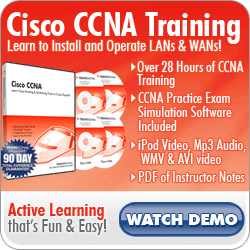Here are the Cisco certification practice exam questions that were posted on Thursday, April 16; answers have been posted below each question. Enjoy!
CCNA And CCENT Certification:
Which of the following statements regarding Cisco routers are true?
A. All interfaces are open by default.
B. By default, all interfaces are closed.
C. There are no preconfigured loopback interfaces.
D. There is a default loopback interface, "Loopback0".
E. Proxy ARP can be disabled with the "no ip proxy-arp" command.
F. Routers cannot run Proxy ARP.
Answers: B, C, E. Cisco router interfaces are closed by default, you have to manually create all loopback interfaces, and you can disable proxy ARP.
CCNA Security:
Name the three violation modes of Port Security, along with a brief description of the differences between the three. Also, identify the default mode.
Answer: The default mode is shutdown, where the port is put into err-disabled state and an SNMP message is generated. In restrict mode, the offending frames are dropped and an SNMP message is generated. In protect mode, the offending frames are simply dropped and no other action is taken.
CCNA Voice:
VTP is an important part of your voice networks. When it comes to the VTP domain name and the password, which are case-sensitive?
A. Both
B. The VTP domain name only
C. Neither
D. The VTP password
Answer: B.
CCNA Wireless:
You want to give the name WIRELESS to your network's VLAN 20. Exactly how can you do this?
Answer: Enter the "vlan 20" command, which will allow you to then name the VLAN, as shown here:
SW1(config)#vlan 20
SW1(config-vlan)#name WIRELESS
And now for today's CCNP training questions!
BSCI Exam:
Short answer: What's the main difference between a "regular" OSPF stub area and a "total" stub area?
Answer: OSPF stub areas replace any E1 and E2 routes with a single IA default route. A stub router’s table still has individual intra-area routes. Configuring an area as a total stub results in stub routers having no external routes, and only a single inter-area route marked as default.
BCMSN Exam:
Short answer: For what purpose would you use the errdisable recovery command?
Answer: To allow a switch port to recover from err-disabled state dynamically after a configurable amount of time, rather than requireing manual reactivation.
ISCW Exam:
Short answer: You're configuring IPS via SDM and notice an option to enable something called "engine fail closed". What happens if you enable that feature?
Answer: Here's the exact description of Engine Fail Closed from Cisco's SDM:
"By default, when IOS compiles a new signature for a particular engine, it allows packets to pass through without scanning for the corresponding engine. Enable this option to make IOS drop packets during the compilation process."
ONT Certification:
Short answer: When it comes to congestion avoidance, we have "RED" and we have "WRED". What does that "W" stand for, and more importantly, what advantage does WRED have over RED?
Answer: The "W" stands for Weighted, which gives us a hint as to the second part of the question. WRED allows you and I as network admins to have a little more control over which packets are dropped during times of congestion, where RED doesn't give us that ability.
Look for more practice exam questions and free Cisco training videos in the other blog posts from this week!
To your success,
Chris Bryant
CCIE #12933
The Computer Certification Bulldog







Comments